One of the three basic ramen flavourings, Miso Ramen is quite simple to make. All you need is to learn how to make the miso flavouring base and just add the Home-made Ramen Broth that I posted in October.
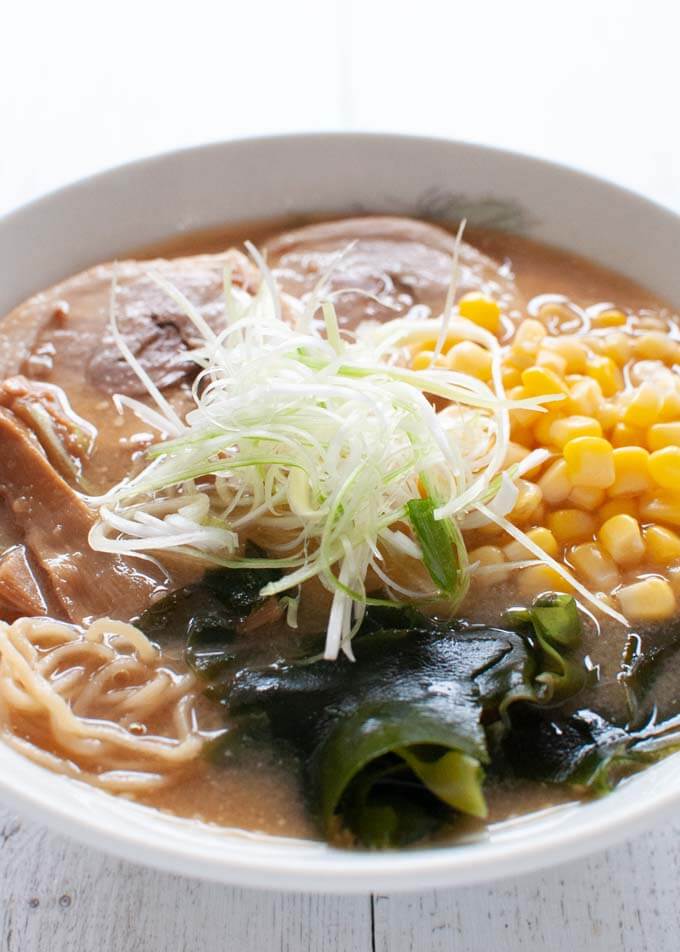
When you think of ramen, perhaps shōyu ramen (soy sauce flavoured ramen) comes to your mind first, because soy sauce flavoured broth is the most common. But in Japan, the popularity of miso flavoured ramen, miso ramen (味噌ラーメン) is almost as high as that of shōyu ramen.
A Japanese food company conducted a survey on ramen some time ago. One of the questions was about favourite ramen flavours. As expected, shōyu ramen came first, but surprisingly miso ramen was the second with a very small margin.
Flavouring Base of Miso Ramen
When I posted Home-made Ramen Broth Recipe, I introduced the word ‘tare’ (flavouring base, pronounce as /tare/, not ‘/teː/’ or’ /teə/’) and added the ‘tare’ for shōyu ramen in the recipe.
Unlike shōyu ramen, the tare for Miso Ramen consists of more ingredients, but you can make it in no time.
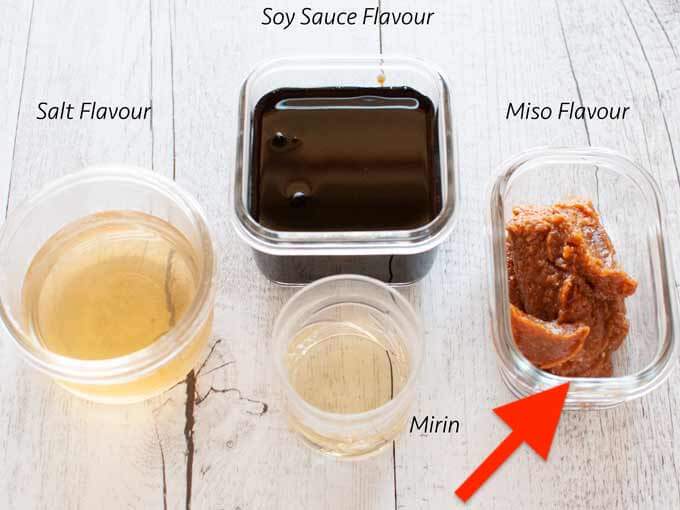
The main ingredient is miso but added to it are sake, soy sauce, mirin, sugar, ground white sesame seeds, garlic, ginger and chilli bean paste/doubanjiang/toban-djan (豆板醤). Boil sake and mirin, then simply mix all the ingredients and voila.
Just like any other flavouring of any dishes, you may want the miso ramen broth to be more garlicy or spicy. Then increase the amount of these ingredients when making the miso flavour base.
Miso Ramen Soup
The ‘tare’ for miso ramen is like a soft miso paste. This needs to be diluted in Ramen Broth to make the soup for Miso Ramen.
You will need 2 tablespoons of miso flavouring base to make 400ml of Miso Ramen Soup. But again, the ratio of miso flavouring base and Ramen Broth depends on how salty you want the soup to be.
People very sensitive to saltiness might want to reduce the flavouring base slightly and, similarly, people who like stronger flavouring may want to increase the miso flavouring base a bit. It’s trial and error to find the right balance for your palate.
Moyashi (Bean Sprouts) Miso Ramen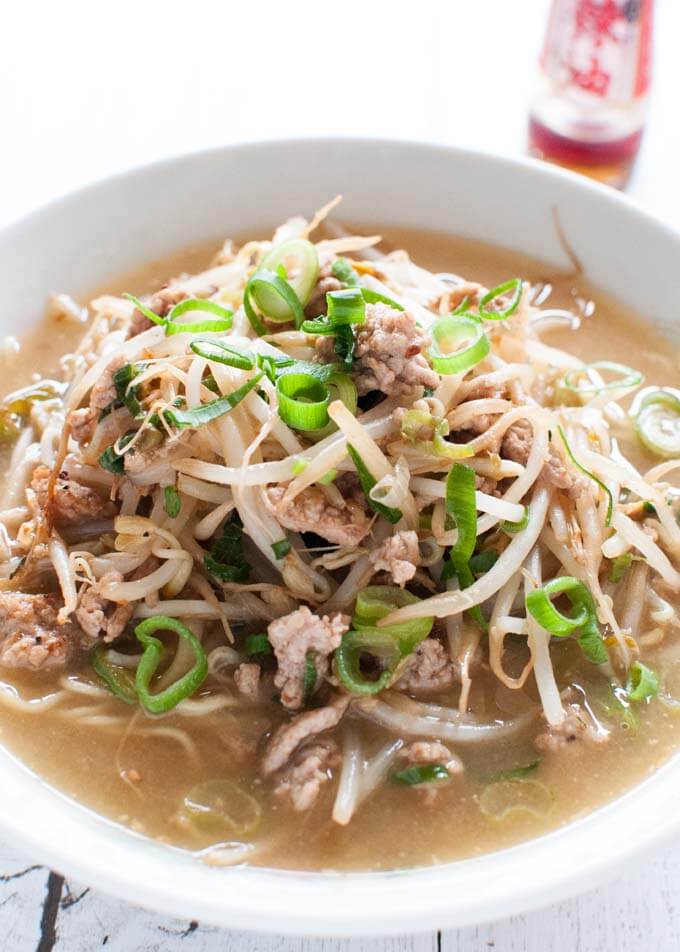
When I think of Miso Ramen, the first ramen toppings that come to mind are stir-fried bean sprouts and pork mince/ground pork. It’s called Moyashi Miso Ramen. I used to like it so much that I ordered moyashi miso ramen every time I went to a ramen shop.
The thick miso-based ramen soup is quite flavoursome and it goes very well with ramen noodles. Stir-fried bean sprouts also match with the miso flavoured soup. When all the noodles have been eaten and you sip the miso flavoured ramen soup, you get bits and pieces of pork mince in the soup. That’s so tasty and satisfying to eat them up.
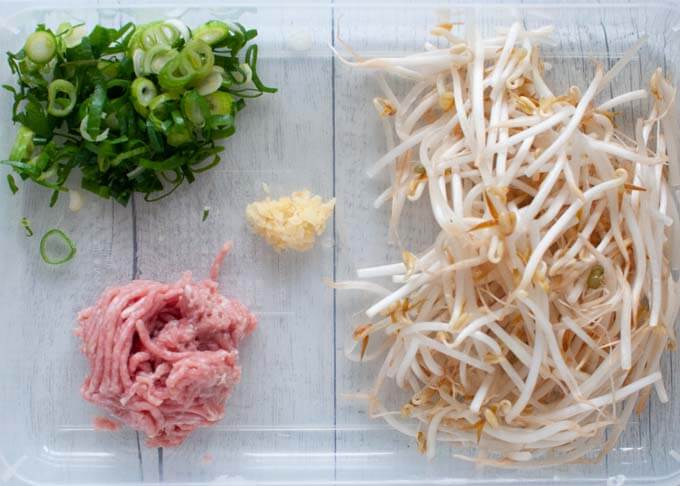
Sapporo Miso Ramen
When talking about miso ramen, I must talk about Sapporo ramen (札幌ラーメン). It is the famous miso ramen that originated in Sapporo (the capital city of Hokkaido prefecture) about 70 years ago. At the time toppings of stir-fried vegetables made this dish unique.
But these days, you will see the usual ramen toppings with corn kernels added to it and sold as Sapporo ramen. Hokkaido is famous for its sweet corn and it harvests the most corn in Japan by far. By adding corn to the ramen, it makes the ramen as if it is a specialty ramen from Sapporo,Hokkaido.
It is quite interesting that most Japanese people think of sweet corn in toppings when they hear the word ‘Sapporo ramen’. But many of the ramen shops in Sapporo actually don’t use corn. I am one of the most Japanese people and I also think Sapporo ramen = sweet corn.
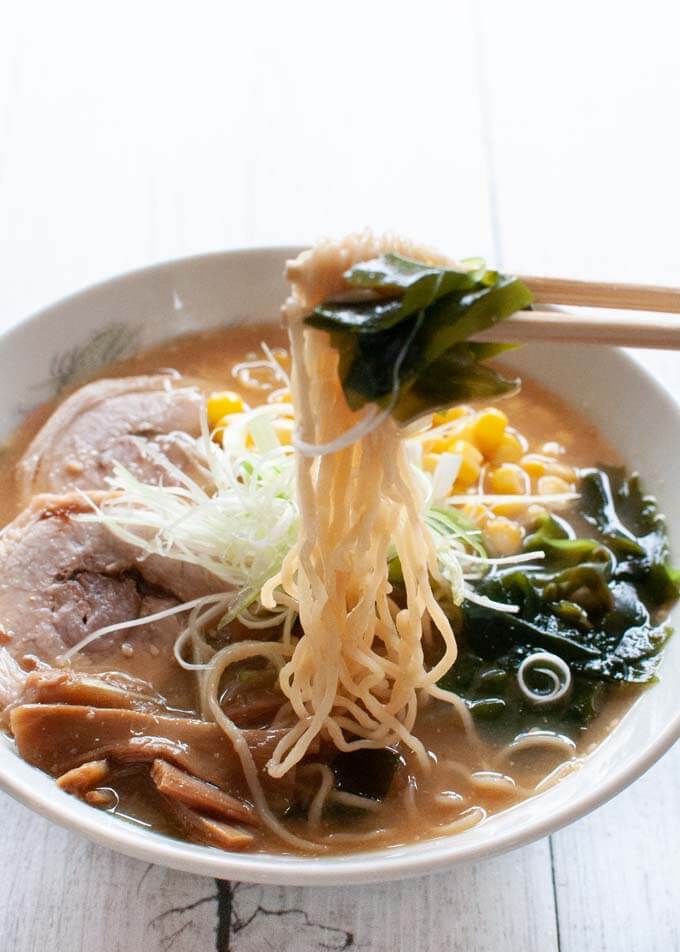
Other Toppings
Just like shōyu ramen toppings, there are no rules as to what should/shouldn’t be included as toppings. In some ramen shops, you will find varieties of ramen toppings and different soup flavourings listed on the menu and you can mix and match them.
I sometimes make Miso Ramen with combination stir-fry (Happosai/Chop Suey).
In today’s Home-made Miso Ramen recipe, I included recipes to make Moyashi Miso Ramen and Sapporo Miso Ramen.
Having mastered Shōyu Ramen (soy sauce flavoured ramen) per my post, Home-made Ramen Broth Recipe and Miso Ramen today, you are almost there to perfect three basic ramen flavourings. I can’t wait to post the last flavouring, Shio Ramen (salt flavoured ramen) sometime later.
Yumiko![]()
PS: I added a new section ‘MEAL IDEAS’ below the recipe card. It gives you a list of dishes that I have already posted and the new recipe in this post that can make up a complete meal. I hope it is of help to you!

One of the three basic ramen flavourings, Miso Ramen is quite simple to make. All you need to learn is how to make the miso flavouring base and just add the Home-made Ramen Broth that I posted in October
In this recipe, I included two different toppings that go very well with miso flavoured ramen soup.
Prep Time and Cook Time includes time to make the Miso Flavouring Base and a Miso Ramen with one of the toppings. Total Time does not include the time to leave the Miso Flavouring Base overnight, nor time to make ramen broth.
- 80-100g/2.8-3.5oz fresh egg noodles (note 1)
- 400ml/13.5oz Home-made Ramen Broth (boiling hot, note 2)
- 2½ tbsp Miso Flavouring Base
- 1 tbsp oil
- 1 tsp ginger finely chopped
- 80g/2.8oz pork mince
- 3 tbsp shallots/scallions , finely chopped
- 1½ cups bean sprouts
- 1 tsp Miso Flavouring Base diluted in 2 tsp water
- ½ tsp soy sauce
- 2 slices Yakibuta (Braised Pork)
- 1 ½ tbsp dried wakame seaweed pieces , rehydrated
- 5 strips of menma (seasoned bamboo shoots, note 4)
- 3 tbsp sweet corn kernels (boiled fresh corn, canned or frozen - defrosted)
- 2 tbsp finely julienned shallots/scallions , curled in iced water
-
Place a small saucepan with sake and mirin in it over low heat.
-
When it starts boiling, add the remaining Miso Flavouring Base ingredients and mix well. The miso mixture becomes pasty and when small bubbles start appearing, turn the heat off.
-
If you are not in a hurry, transfer the miso paste to an air-tight container and store in the fridge overnight before using to allow development of good flavour.
-
Place 2½ tablespoons of Miso Flavouring Base in a serving bowl.
-
Boil water in a saucepan and cook noodles as per the instructions and drain.
-
While boiling the water in the saucepan, heat a frying pan with oil in it over medium high heat.
-
Add ginger and pork mince and cook for 1 to 1½ minutes, breaking the mince but keeping some larger chunks.
-
When the mince is cooked through, add ⅔ of copped shallots, bean sprouts and stir-fry for 30 seconds.
-
Add the miso flavouring and soy sauce and stir for another 30 seconds. Turn the heat off.
-
Add a small amount of Ramen Broth to the bowl with miso, mix and dilute the miso base.
-
Add the remaining Ramen Broth keeping about 50ml and taste test. Adjust the saltiness with remaining Ramen Broth.
-
Add the noodles topped with the bean sprouts stir-fry. Sprinkle the remaining chopped shallots over and serve immediately.
-
Place 2½ tablespoons of Miso Flavouring Base in a serving bowl.
-
Boil water in a sauce pan and cook noodles as per the instructions and drain.
-
Add a small amount of Ramen Broth to the bowl with miso, mix and dilute the miso base.
-
Add the remaining Ramen Broth keeping about 50ml and taste test. Adjust the saltiness with remaining Ramen Broth.
-
Add the noodles. Place Yakibuta slices, menma strips, wakame seaweed and sweet corn, topped with julienned shallots, in the middle.
1. Time to cook noodles varies depending on the type of noodles as well as your preference. Follow the instructions on the pack as a guideline.
2. Please visit my post, Home-made Ramen Broth Recipe.
3. Chilli bean paste is called doubanjiang or toban-djan (豆板醤). You can buy a bottle of doubanjian at Asian grocery stores.
4. Menma is fermented and seasoned bamboo shoots strips. See the photo below.
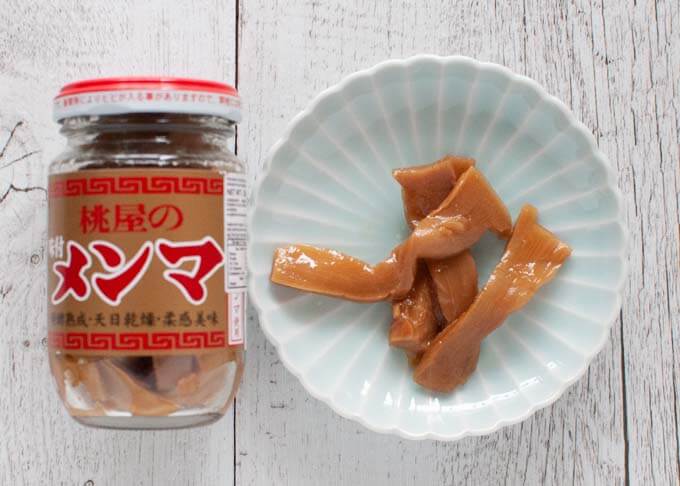
Menma is a must-have topping of the simple ramen which consists of just a couple of slices of pork and shopped shallots/scallions.
They are sold either in a glass bottle or in a vacuumed plastic bag. You can buy menma at Japanese/some Asian stores.
5. Miso flavouring base can be kept in the fridge for a week or so. It can also be frozen.
Meal Ideas
A typical Japanese meal consists of a main dish, a couple of side dishes, a soup and rice. I try to come up with a combination of dishes with a variety of flavours, colours, textures and make-ahead dishes.
You can match with the sides suggested in my ramen recipe, Home-made Ramen Broth Recipe, if you like. But Miso Ramen soup is quite rich with a lot of miso, plain dishes will go well with Miso Ramen. I included Kimchi because chilli and Miso Ramen are good mates.
- Main: Miso Ramen – today’s recipe, either Sapporo Miso Ramen or Moyashi Miso Ramen. Broth and Miso flavouring base can be made ahead.
- Side dish 1: Dashimaki Tamago – make ahead
- Side dish 2: Simple Kimchi Recipe – make ahead
- Salad: Japanese Okra with Bonito Flakes
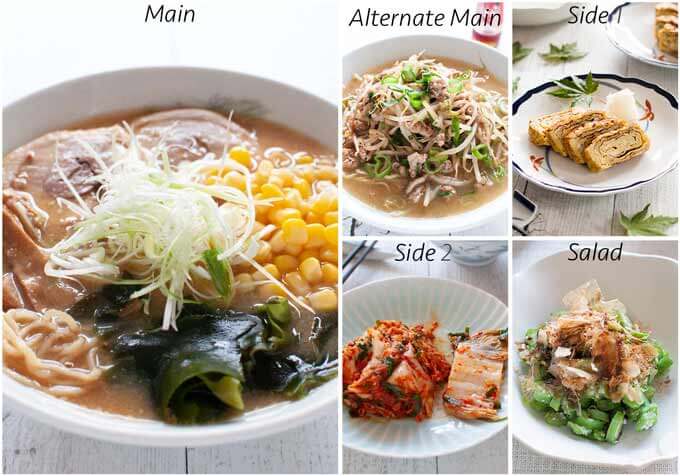
Missing going to Japan and my kids love everything about it especially the ramen. Thank you for sharing this so we could make it at home without using the instant ramen all the time! So much more authentic and healthier.
Could you please let me know where is the best place to buy some Japanese design ramen bowls in Sydney to complete the experience…? 😀
Hi Emily, I live in Gladesville and in Top Ryde shopping centre, there is a place called Japan City. It sells Japanese kitchenware and other goods. They have a small collection of bowls. Also, I recently discovered a shop called Direct From Japan, in Yagoona, which is probably one of the Japanese ceramic shops in Sydney that stock large number of plates and bowls. I hope you can find bowls that you like.
The very traditional authentic ramen bowls are those with dragon drawings on the inside and the dark orange colour on the outside (like my ramen bowl in the photo, although the dragon faded a lot). It is probably very difficult to find those unless you source it from Japan. These days, ramen shops in Japan don’t use the bowls with dragons. They tend to use modern-style of ramen bowls.
Hi Yumiko. So grateful to come across your website. All the recipes i tried from this website turned out great!! Would you do recipe for mazesoba/mazemen please. Can we use the miso tare as the sauce of the noodle without broth? Thank you! Xx
I have never tried mazesoba, which I think is a Taiwanese dish. I had tsuke men which is eaten in the similar way to cold soba with a dipping sauce, although the dipping sauce is richer and usually thick.
If I have an opportunity to eat mazesoba, I can try to work out a recipe.
Thanks for the recipe, I like the combination of flavors. However, I thought it was too sweet so I’ll omit the 1/2 tsb of sugar for next time.
Hi Lee, it is possible that your miso was sweeter than mine and you are right to make some adjustment to suit to your palate. I might add a note to the recipe about it. Thanks for the feedback.
Nagi, I love your dozer. He is absolutely gorgeous and so loving.
Hope you are feeling better.
Nagi I love Dozer, he is absolutely so gorgeous and loving. Hope you are feeling better.
Hi, your comment came through to RecipeTin Japan. I’ll pass on to Nagi.
OMG mum! I want a giant bowl of this RIGHT NOW! 😩
It was sooooo yummy! Sorry that I could not deliver it to you. You live too far.
Looking forward to making this after the holidays. thanks for sharing. Simply delicious sounding.
Hi Lyn, please let me know what you think of it!